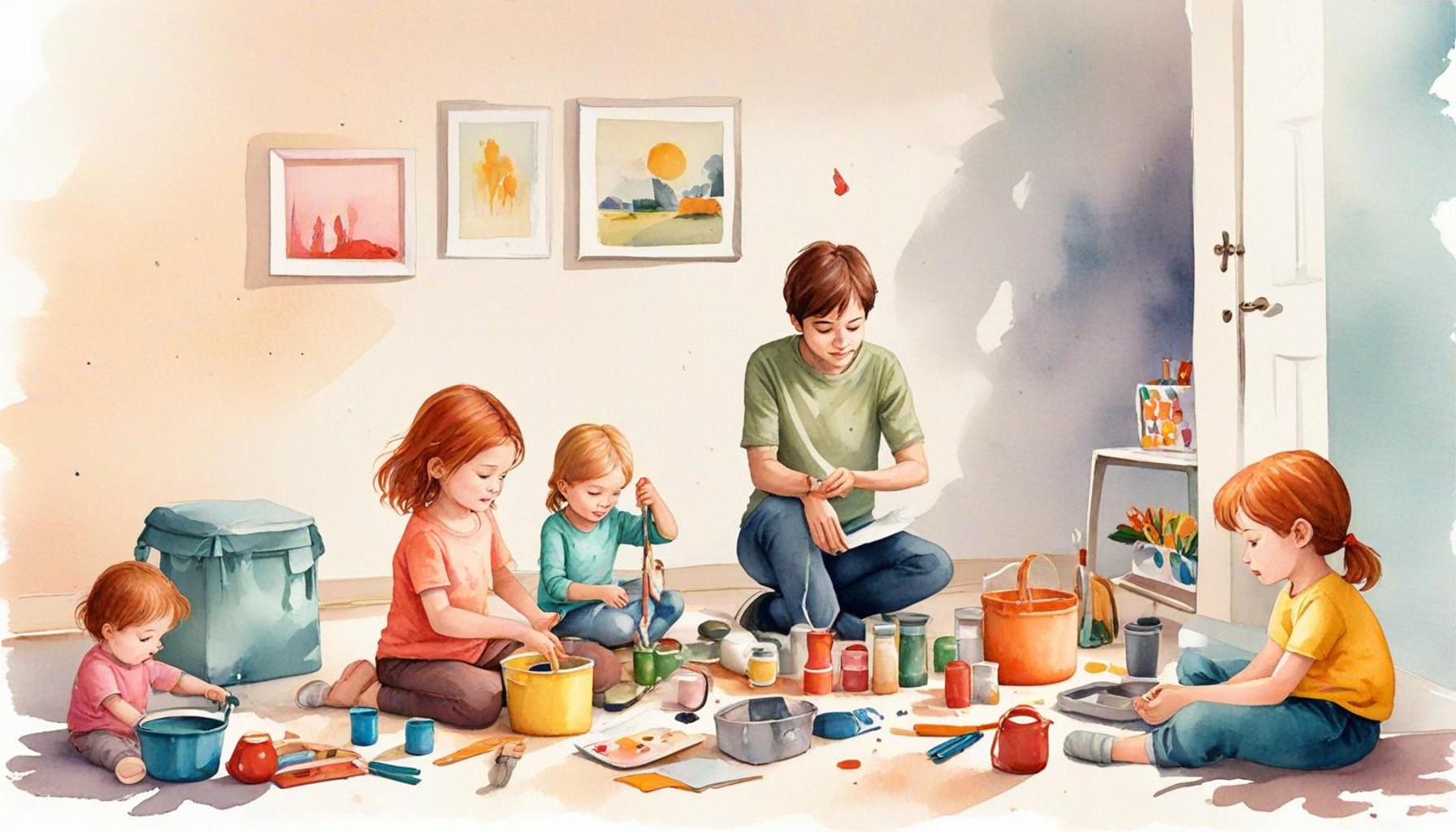Minimalism in the Family: Involving Children in Reducing Household Clutter

Understanding Minimalism in Family Life
As families navigate the complexities of modern life, many are discovering the transformative power of embracing minimalism. This philosophy emphasizes simplicity, both in our physical environment and in our emotional connections with one another. Minimalism is not just about having fewer things; it is a holistic approach to life that prioritizes meaningful experiences and relationships over material possessions. One of the most effective ways to adopt minimalism in the home is to involve children in the decluttering process.
When children participate in reducing clutter, they gain critical life skills that will serve them well into adulthood. For instance, they learn to value experiences over possessions. This fundamental shift in perspective is best exemplified through family activities that create lasting memories, such as camping trips, baking together, or visiting local museums. These experiences often resonate more profoundly than the fleeting joy of acquiring a new toy or gadget.
- Practice decision-making: Children become active participants in deciding what items to keep and what can be donated or discarded. This process teaches them responsibility and enhances their critical thinking skills. For example, when a child faces a choice between keeping a superhero action figure or a beloved book, they learn to weigh their attachments against the memories associated with each item.
- Appreciate simplicity: A decluttered space can lead to a more serene environment. When children help clear their rooms or shared family spaces, many report feeling less overwhelmed and more focused on their studies and hobbies. Studies indicate that a calm and orderly home can foster creativity and mental clarity, essential attributes for young minds.
Moreover, including children in the decluttering process promotes teamwork among family members. As siblings and parents work side by side, they engage in discussions about their values and priorities. This cooperative effort not only strengthens family bonds but also cultivates essential qualities such as gratitude and mindfulness. For instance, reflecting on the joy of giving away unused toys to children in need can impart valuable lessons about generosity and community support.
Numerous studies highlight the positive mental health outcomes associated with minimalism. Research published in Psychology Today demonstrates that tidying up living spaces can substantially alleviate anxiety and promote greater focus. Families practicing minimalism report feeling more relaxed, further contributing to a harmonious home atmosphere.
As you contemplate ways to invite your children into the minimalism journey, think creatively about how decluttering can become an enjoyable and rewarding experience for the whole family. Unleashing the benefits of minimalism can genuinely reshape your household dynamic, ultimately leading to a more enriching family life filled with shared experiences and cherished memories.

DISCOVER MORE: Click here to learn how to reduce stress with intentional living
Engaging Children in the Decluttering Journey
As many families face the growing challenge of overwhelming clutter, finding a way to involve children is paramount. Decluttering with kids can be a transformative experience, teaching them not only how to manage their space but also instilling essential life lessons. This collaborative endeavor fosters a sense of accountability and ownership in children, encouraging them to contribute to a serene household environment.
Start with Small Steps: Introducing the decluttering process should be gradual and age-appropriate. Begin by choosing a single area of the home, such as a toy box or bookshelf, and set aside dedicated time to sort through items together. It’s essential to approach this task with patience and an understanding that children may have emotional attachments to certain possessions. A helpful method is to use the “four-box” system: keep, donate, sell, and trash. This gives children clear categories and minimizes confusion.
- Preserving Memories: Teach children to value their favorite items by focusing on quality over quantity. Encourage them to choose a few high-value toys or books that hold special memories, leaving space for cherished experiences to flourish.
- Creating a Donation Station: Designate a specific spot in the home where children can place items they’re ready to part with. This tangible action reinforces the idea of giving back and supports the development of empathy.
- Gamifying the Process: To keep children engaged, turn decluttering into a game. Set a timer and see how many items can be sorted in a given timeframe or implement friendly competitions among siblings to incentivize participation.
A significant aspect of involving children in the decluttering process is fostering open communication. Encourage discussions about why certain items are being kept or discarded, promoting critical thinking and reflection on personal values. For example, a simple conversation about the difference between a toy that sparks joy and one that simply takes up space can lead to profound realizations about consumerism and the importance of making intentional choices.
Additionally, education on minimalism can be woven into family activities. Organizing workshops or reading books related to the concept can further enhance their understanding and appreciation of living minimally. Such initiatives not only spark curiosity and discussion but also align family goals towards a more mindful lifestyle.
As families embark on this decluttering journey together, they create opportunities for bonding and meaningful conversations about their values and priorities. Integrating children into the process fosters teamwork and nurtures an appreciation for simplicity that can stay with them throughout their lives. Thus, minimalism in the family becomes not just about reducing physical clutter, but also a holistic approach to nurturing emotional connections and promoting responsible citizenship.
| Advantage | Description |
|---|---|
| Enhances Responsibility | Involving children in decluttering routines fosters a sense of responsibility and ownership over their belongings. |
| Encourages Decision-Making | Children learn to make decisions about what items are important to them, promoting critical thinking skills. |
| Strengthens Family Bonds | Collaborating on decluttering projects can create a shared experience, enhancing family relationships. |
| Facilitates Mindfulness | Children develop a mindful approach to possessions, learning to appreciate what they have. |
A minimalist lifestyle not only impacts the physical space within a home but also significantly influences family dynamics. Involving children in the process of reducing clutter serves multiple purposes beyond mere organization. As families engage in decluttering together, they cultivate important life skills in children while also reinforcing family relationships. Transitioning to a minimalist approach nurtures a sense of empowerment among children, where they understand the value of their choices and the significance of keeping only what is essential. This method provides a platform for children to express their preferences, ensuring they remain mentally engaged in the process. Ultimately, the journey towards a minimalist home paves the way for an experience full of lessons that resonate throughout family life and beyond.
DIVE DEEPER: Click here to learn how to transform your personal organization
Instilling Lifelong Values Through Minimalism
The journey toward minimalism within the family is also an opportunity to instill lifelong values in children, creating a foundation for responsible decision-making and environmental consciousness. As kids engage in the decluttering process, they begin to understand the significance of their choices and how these choices impact not only their immediate living space but also the world around them.
Environmental Awareness: Teaching children about waste reduction and sustainability is integral in our current climate crisis. Explain how donating toys and clothes helps those in need and reduces landfill waste. According to the Environmental Protection Agency (EPA), the average American generates about 4.9 pounds of waste each day, with a significant portion comprised of unnecessary items. By engaging in decluttering, children learn to view their possessions through a more socially and environmentally conscious lens. Families may even take trips to local charities, providing tangible connections between decluttering and positive community impact.
Financial Literacy: Minimalism can also pave the way for lessons in financial responsibility. Families can discuss the concept of “buying less” and how thoughtful purchasing reduces clutter in the long run. Engaging children in budgeting discussions regarding their allowance or savings can demonstrate how thoughtful purchases foster a clearer space and prevent the cycle of consumerism. For instance, when children recognize that the money spent on impulsive purchases could be saved for future experiences, they learn the value of prioritizing quality over quantity.
Encouraging Creativity: In a clutter-free environment, children often rediscover their creativity. With fewer distractions, they can focus more on activities that stimulate their imaginations such as drawing, crafting, and reading. The space left by decluttering allows for designated areas for projects, children’s books, or performance stages for impromptu shows. This newfound clarity enhances mental well-being and motivation, which are instrumental in childhood development.
Building Responsibility: Assigning age-appropriate tasks reinforces personal accountability. For younger children, creating a “clean-up chart” can instill the habit of daily organization. Not only does this task heighten their sense of responsibility, but it also cultivates a routine in healthy organizational habits. For older children, involving them in planning family purchases and involving them in discussions about new acquisitions helps solidify their understanding of the importance of mindful choices.
Teaching Mindfulness: Mindfulness practices—an integral aspect of minimalism—can also be introduced to young families. This can range from simple yoga exercises to guided meditations focused on gratitude for what they own. Techniques such as these encourage children to embrace living in the present and appreciating their belongings without clinging to excessive materialistic desires. Such practices can nurture a deeper connection with their immediate environment and relationships, helping to reduce anxiety and enhance emotional intelligence.
By embedding these values into family life through the lens of minimalism, families can create an ongoing dialogue about personal growth, societal impact, and responsible citizenship. These experiences will not only inventory their household items but also shape children’s identities, establishing habits that will last well into their adult lives.
DISCOVER MORE: Click here to enhance your time management skills
Conclusion: Embracing Minimalism as a Family
In summary, embracing minimalism in the family serves as a powerful tool not only for reducing household clutter but for fostering essential life skills in children. By actively involving kids in the decluttering process, families cultivate a sense of responsibility, awareness, and mindfulness that stretches far beyond the confines of their home. The discussions around environmental sustainability and the impact of consumerism on their pockets and the planet create a generation of conscious consumers who prioritize need over want.
Furthermore, the uncluttered spaces will promote creativity and inspiration, allowing children to explore their interests in an environment free of distraction. Tasks, whether it’s sorting through toys or deciding what items bring joy, become invaluable lessons that lay the groundwork for financial literacy and responsible decision-making.
As we advocate for a minimalist lifestyle, it’s crucial to remember that this journey isn’t merely about physical space; it’s about fostering connections and encouraging an ongoing dialogue around values, experiences, and community engagement. Introducing children to the principles of minimalism can inspire them to carry these lessons into adulthood, creating not only organized spaces but also thoughtful lives.
As families embark on this transformative journey, they aren’t solely decluttering their homes; they are simultaneously enriching their relationships, instilling meaningful habits, and nurturing responsible, environmentally aware individuals. The path to reducing household clutter is a communal effort, one that elevates the family unit while planting the seeds for a more sustainable future.



